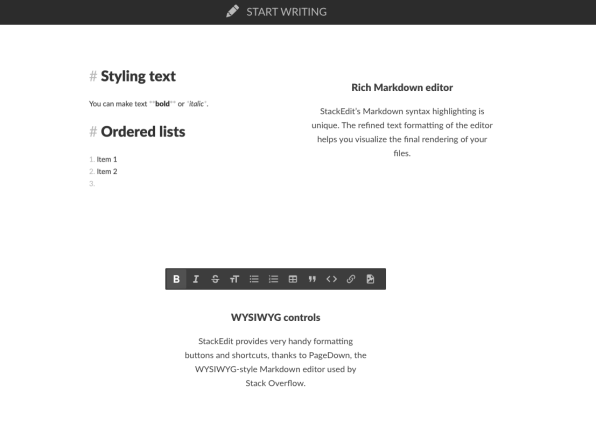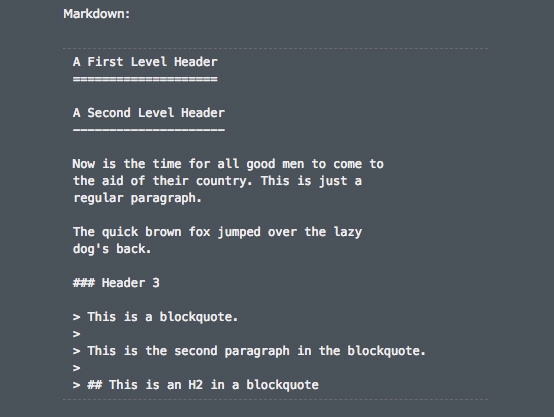For focused writing, Markdown is your best friend
A few years ago, I had what seemed like a clever idea: What if there was a text editing program with less clutter than Microsoft Word and more focus on writing for the web?
I quickly discovered that such a thing already existed thanks to Markdown, a text-editing language created 14 years ago by writer and programmer John Gruber, also known for his Daring Fireball blog. At its core, Markdown is a kind of shorthand for the HTML code that web publishing requires. But you might also think of it as a means to distraction-free writing, with software that’s often simpler and less cluttered than Word. These days, I default to writing and taking notes in a Markdown editor, even when I’m not publishing the material online.
Despite being more than a decade old, Markdown seems to be entering a golden age, popping up in new places and getting used in new ways. There’s even a chance you’ve written in a Markdown-friendly editor before without realizing it. So now’s a better time than ever to familiarize yourself with the language and the apps you can use with it.
How Markdown works
In a way, Markdown apps are similar to plain text editing programs like Notepad in Windows or TextEdit in MacOS. There are no fonts to select, no pages to align, no highlights, no colors, and no comments. All that’s left are you and the words.
But unlike those basic text editors, Markdown still allows you to format those words with headlines, bold text, italics, lists, and links, similar to what you can do on a web page. You accomplish this by inserting special symbols in front of or around the text you’re trying to format. A single # symbol at the start of a line, for instance, creates a large heading, and a pair of asterisks will italicize whatever words are in between them. The Markdown software can then convert those characters to HTML for easier reading or publishing on the web, so writing this:
The **quick brown fox** jumps *over* the [lazy dog](https://en.wikipedia.org/wiki/The_quick_brown_fox_jumps_over_the_lazy_dog).
Would result in this:
The quick brown fox jumps over the lazy dog.
This might seem a bit daunting at first, but good Markdown editors don’t require you to memorize the language outright. Some provide shortcut keys or right-click menus, so you can highlight the text you want to format, press a button, and drop in the required code. Many Markdown editors also provide live HTML previews, so you can see how the code would look on a web page.
Over time, you’ll likely start to memorize those shortcuts on your own, and realize that typing the characters yourself is often faster and less distracting than taking your hands off the keyboard to click a button. And once that happens, you’ll probably be hooked.
The main purpose of Markdown is to generate HTML code that you can copy onto a web page or into writing platforms such as WordPress. But you don’t have to use it that way. Markdown can also be the basis for powerful note taking, and many Markdown editors can export your writing into other formats such as Word documents.

The best Markdown editors to try
The easiest way to check out Markdown is on StackEdit.io, an open-source editor that runs in any web browser. It provides shortcut buttons for formatting, a live preview panel to see how your code will look, and a variety of exporting and publishing options. You can even sign in with a Google Drive or Dropbox account to sync your work across multiple devices.
Still, you’re not confined to a single program. Most editors will save your files in the .md format, which you can then load in any other editor on your phone, tablet, or computer. If you save those files in a cloud storage drive, you can easily pick up your work on any device.
On Windows, my favorite Markdown editor by far is Typora, which is still in beta but stable enough to use every day. (It’s also available for Mac.) Unlike most Markdown editors, Typora hides formatting symbols after you’ve typed them, so the area where you’re writing actually looks like a live web preview. (Most editors instead relegate this preview to a separate window.) Typora seems to require a decent amount of processing power–typing gets a bit laggy on my Surface Pro 3–but it’s a killer writing app for desktop computers, and it can export to a variety of formats including Word and PDF.
Meanwhile, Apple’s iPhone and iPad have become host to a vibrant Markdown editing scene. The popular note-taking app Bear (for both iOS and Mac) supports writing in Markdown, so you can either type out the formatting symbols or use on-screen shortcut buttons. Ulysses is a powerful Markdown editor with lots of organization features that can publish directly to WordPress and Medium, and it recently switched to a subscription model to work seamlessly across iOS and Mac. iA Writer focuses on minimal menus and support for various cloud storage services. (It’s also available on Windows, Mac, and Android.) Drafts lets you set up handy automations, so you can export notes to other apps, sort your text, and more.
Personally, though, I’ve become hooked on Pretext, which closely resembles a plain text editor but can recognize and highlight Markdown syntax. It’s fast and simple, and it integrates with iOS 11’s Files picker, so you can save and load .md files directly into cloud storage services such as Dropbox, Google Drive, and iCloud Drive.

Markdown without Markdown
Once you’ve gotten a handle on Markdown, you might start noticing it in places you hadn’t before.
Slack, for instance, borrows some elements of Markdown for formatting messages, so you can embolden text with asterisks and use the greater-than sign for block quotes. Reddit offers similar formatting options for its own comments. The collaborative document editors Quip and Dropbox Paper both support some Markdown formatting commands, and can export documents as .MD files. If you ever get into coding, the development platform Github uses Markdown for documentation. And, in perhaps the strongest endorsement yet of writing in Markdown, the New York Times recently built its own story editor with ProseMirror, an open-source tool for creating Markdown-based text editors.
Clearly, age hasn’t been a hindrance for Markdown, whose simplicity has allowed all kinds of new apps and uses to flourish in recent years. If you’re fed up with writing in Word or other traditional text editors, perhaps it’s time to harness some of that simplicity for yourself.
(8)




